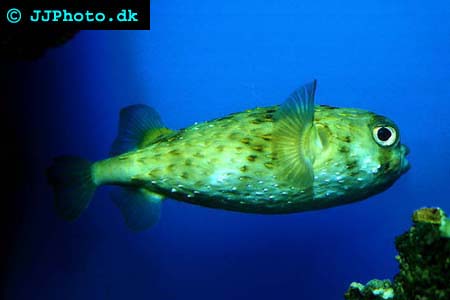Many different species in the family
Diodontidae of the order
Tetraodontiformes are commonly known as
Porcupine puffer fish. They are closely related to the various Pufferfish species in the family
Tetraodontidae, but unlike the
Tetraodontidae species, the Porcupine puffer fish is equipped with spines. The Porcupine puffer fish is also known as Porcupinefish, Burrfish and Balloonfish, and it is popular among saltwater aquarists.
The name
Diodontidae is derived from Greek and literary means “two teeth”. All Porcupine puffer fish species have jaws with two fused teeth, which make them somewhat similar to parrots. These fishes also have opposite premaxillaries and the dentaries are united at midline. The Porcupine puffer fish use its strong jaws and teeth when feeding on hard-shelled invertebrates that need to be crushed prior to consumption.
The family
Diodontidae contains 19 different known species that belong to 6 different genera. All Porcupine puffer fish species are marine and/or brackish and they should not be kept in freshwater aquariums. Since many species grow very large they are suitable only for aquarists with very large aquarium. The Spot-fin Porcupine puffer fish (
Diodon hystrix) can for instance grow over 90 centimetres long. There are however several Porcupine puffer fish species that stay below 30 centimetres even as adults, such as Striped burrfish (
Chilomycterus schoepfii), Guinean burrfish (
Chilomycterus spinosus mauretanicus), Hardenburg's burrfish (
Cyclichthys hardenbergi ), Pelagic porcupinefish (
Diodon eydouxii ) and
Chilomycterus spinosus spinosus, a fish that has no widespread English name.
Wild Porcupine puffer fish is widespread and can be found in the Atlantic Ocean, in the Pacific Ocean and in the Indian Ocean. Generally speaking, young Porcupine puffer fish are pelagic while adult specimens prefer to stay inshore. The Porcupine puffer fish is an egg-laying species and breed in pelagic waters. They do not guard their offspring.
A Porcupine puffer fish must be provided with a large aquarium. Most species can be housed in an aquarium that is 65 gallons or larger. The Porcupine puffer fish needs alkaline conditions and a water temperature between 75 and 82° Fahrenheit. It is important to keep in mind that the spines on your Porcupine puffer fish are very sharp and capable of injuring careless aquarists. In some Porcupine puffer fish species, the spines will only be erect when the fish is puffed up.

Diodon hystrix the true Porcupine puffer fish. A marine species.
Copyright
www.jjphoto.dk
The Guinean burrfish (
Chilomycterus spinosus mauretanicus) mentioned earlier in this article is one of the smallest known Porcupine puffer fish species. The largest specimen ever found was no longer than 25 centimeters. This Porcupine puffer fish inhabits the waters off the coasts off Cabo Blanco, Mauritania to Angola, and sometimes a few examples will stray further to the South African coast. It is not a popular food fish, since many people believe that the Guinean burrfish is toxic. Even though there is no scientifically reliable proof to back up this belief, the fish is still banned in several countries. This Porcupine puffer fish prefer sandy and muddy bottoms and has debt range of 100 meters. Just like most other Porcupine puffer fish species, it feeds primarily on mollusks and other hard-shelled animals.



